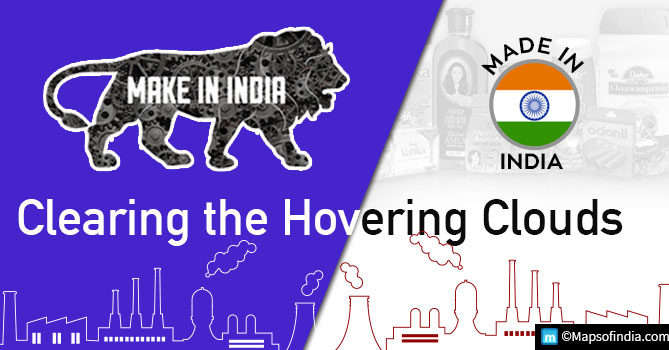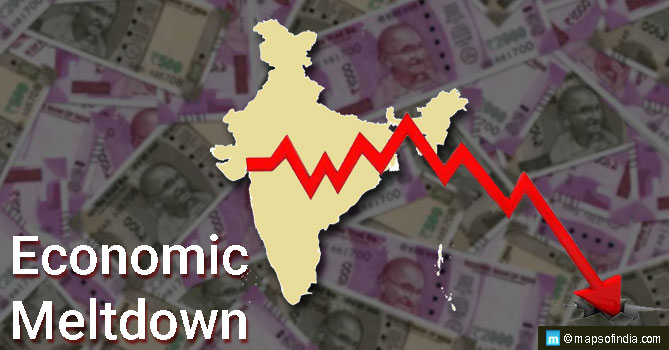‘Make in India’ and ‘Made In India’ have become a topic of debate in recent times with a lot of confusion surrounding the difference between the two. Most of us think of them as the same concept but precisely, they are two different economic programs. Discussing these in detail will help us in getting a fair idea of both initiatives launched by the government.
Make in India
Make in India is an initiative launched by Prime Minister Narendra Modi in 2014 to deal with the issue of stagnating Indian economy and boosting the economic growth of the country, when his NDA government took over the reigns of the Indian Parliament.
It aimed at making India an attractive destination for the foreign investors from all over the world and building a credible business atmosphere with ease of doing business by removing various trade barriers in foreign policies. The foreign investors were encouraged to utilize India’s untapped manufacturing potential through Foreign Direct Investment (FDI) and make the country a credible manufacturing ground worldwide.
The advantages underlying this propaganda led many companies from all over the world to make huge investments under this initiative, making India a hub for the manufacturing companies.
Benefits
- Make in India initiative helps in creating jobs for ever-increasing population of India.
- Conversion of India into a manufacturing hub of various commercial products.
- Development of the areas and the neighboring locations where the industries would be set up.
- The program will boost the GDP of the Indian economy as foreign investments will lead to humongous flow of income.
- The FDI under this initiative would strengthen the rupee against the domination of the American dollar.
- As countries from all over the world will bring along latest technology, India will have an opportunity to make use of it as it lacks in various test mechanization.
- Setting up of industries under this initiative will help in the development of rural areas.
Drawbacks
- Under Make in India campaign, all the focus lies on the manufacturing sector. So this causes a negative impact on the agriculture sector of India.
- As setting up manufacturing industries requires natural resources like land, water, etc on a large scale. So, there is a possibility of depletion of these natural resources which can threaten the survival of such large population of India.
- Entry of foreign countries into the manufacturing sector in India has caused a threat to the existing small local entrepreneurs and might force them out of business.
- A wide disruption in the agricultural sector due to the utilization of land primarily for setting of manufacturing industries.
- Tough competition leads to lowering of returns on FDI and results in outflow of capital from the economy.
- Unemployment will be created if the foreign investors back out from the initiative.
Made in India
‘Made in India’ initiative gave an identity to the products being manufactured in India. This program does not attract any foreign investors and believes inefficient utilization of the country’s available resources. It encourages domestic manufacturers to produce goods in the country by using factors of production like land, labor, capital, entrepreneurship, and technology, thereby generating employment opportunities for the Indian masses. If this program is promoted efficiently, it would definitely recognize and endorse the Indian homegrown brands. It will provide the domestic manufacturers with a platform to compete with foreign products and raise the standard of their products.
Benefits
- Efficient utilization of the country’s talent and resources to manufacture a product
- Generation of employment opportunities for the Indian masses
- Promotes domestic manufacturers to produce goods in India
Drawbacks
The current circumstances of the Indian economy are unfavorable for the domestic brands. The BJP government is focusing more on the Make in India as it will make the country globally recognized because the government is trying to bring in competition and improve the quality of Made in India products. The deficiency in the quality of the domestic products has led to a fall in the exports and a decrease in the consumer base.
The Major Differences
Firstly, Make in India focuses more on attracting the foreign investors to make investments towards the factors of production required in the Indian manufacturing sector. Whereas, Made in India primarily aims at domestic factors of production (including investments) in the manufacturing of products.
Secondly, Make in India is not a brand but a strategy of the Indian government to deal with the issue of sluggishness in the Indian manufacturing industry. Made in India refers to branding of products manufactured in India and building their identity in the Indian as well as foreign markets.
Thirdly, the profits generated under Make in India initiative will also consist of the share of foreign investors while the profits earned from Made in India initiatives is retained within the Indian economy.
Both the policies seem to benefit the Indian economy in their respective ways. On one hand, Make in India will boost foreign investments in the economy and on the other, Made in India will help the country being self-reliant in terms of manufacturing of products. Therefore, a logical route is needed to be adopted.
India’s major concern is the lack of financial resources available with the domestic manufacturers due to which the quality of the products gets compromised. If they would be supplied with sufficient financial resources, the quality and standards of the domestic products will get improved. For this, Make in India propaganda can come into play. The campaign can be utilized to generate good amounts of means in the form of FDIs for the domestic manufacturers so that they can manufacture good quality products domestically. This will also help them and their products to gain self-reliability and global recognition. Once they have achieved a stage of stability, they can gradually shift to manufacturing their products under Made in India campaign.





